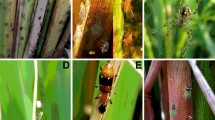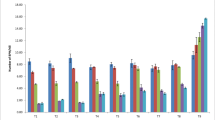Abstract
Dominant 20 SG (dinotefuran 20% SG), an insecticide of neonicotinoid class (blue toxicity label), was evaluated @ 20, 30 and 40 g a.i. ha−1 (100, 150 and 200 g ha−1, respectively) against rice planthoppers viz. brown planthopper (BPH) and the whitebacked planthopper (WBPH) infesting rice. The test insecticide was compared with the checks Chess 50 WG (pymetrozine) @ 300 g ha−1, Osheen 20 SG (dinotefuran) @ 200 g ha−1 and Ekalux 25 EC (quinalphos) @ 2000 ml ha−1. Dominant 20 SG showed increased efficacy in suppressing the BPH with increase in the concentration of the insecticide and days after spraying. Dominant 20 SG was statistically at par with the check, Osheen 20 SG recording 1.66 BPH/hill with 80.12% suppression in BPH population after 3 days of insecticide application. Similar results with the test insecticide were also observed against whitebacked planthoppers. After 7 days of insecticide application, the test insecticide @ 40 g a.i./ha recorded population of 1.59 hoppers/hill (pooled mean of 5 locations) and it was at par with Osheen 20 SG (1.63 hoppers/hill). Highest paddy yield of 73.21 q/ha was obtained with Dominant 20 SG @ 200 g ha−1 which was statistically higher than the paddy yield of 72.96 q/ha in Osheen 20 SG @ 200 g ha−1. In basmati rice, Dominant 20 SG resulted in paddy yield of 35.15 q/ha, at par with the check, Osheen 20 SG (35.00 q/ha) at its highest dose of 200 g ha−1.
Similar content being viewed by others
References
Adhikari B, Jayaraj P, Dohling PNK (2019) Pymetrozine: an effective insecticide for management of planthoppers in rice. J Entomol Zool Stud 7(1):528–531
Anonymous (2022a) Agricultural production. http://www.indiastat.com
Anonymous (2022b) Package of practices for kharif crops. Punjab Agricultural University, Ludhiana
Bae SH, Pathak MD (1970) Life history of Nilaparvata lugens (Homoptera: Delphacidae) and susceptibility of rice varieties to its attacks. Ann Entomol Soc Am 63(1):149–155
Chen CN, Cheng CC (1978) The population levels of Nilaparvata lugens (Stål) in relation to the yield loss of rice. Plant Prot Bull 20(3):197–209
Chen CC, Ku WH, Chiu RJ (1978) Rice wilted stunt its transmission by the brown planthopper, Nilaparvata lugens (Stål). Plant Prot Bull 20(4):374–376
SPSS (Statistical Package for the Social Sciences) (2011) IBM SPSS Statistics for Windows, Release 20.0. Armonk, NY, IBM Corp
Dhaliwal GS, Arora R (2010) Integrated Pest Management. Kalyani Publishers, New Delhi, p 369
Hardy B, Heong KL (2009) Planthoppers. New threats to the sustainability of intensive rice production systems in Asia. International Rice Research Institute, Los Baños
Horgan F (2009) Mechanisms of resistance: a major gap in understanding planthopper-rice interactions. In: Heong KL (ed) Planthoppers. New threats to the sustainability of intensive rice production systems. International Rice Research Institute, Los Baños
Hurali S, Biradar R, Vinoda GSB, Masthanareddy BG, Mahantashivayogayya H, Pramesh D (2020) Field performance of a new formulation of dinotefuran 70% WG against sucking pests of paddy. J Entomol Zool Stud 8(1):1011–1015
Konchada D, Chennamasetty RRV, Choragudi SR (2017) Evaluation of Newer Insecticides aganist Brown Planthopper, Nilaparvata lugens (Stal.) Infesting Rice. Chem Sci Rev Lett 6(23):1423–27
Ling KC, Tiongco ER, Aguiero VM (1978) Rice ragged stunt, a new virus disease. Plant Dis Rep 62(8):701–705
Liu JL, Yu JF, Wu JC, Yin JL, Gu HN (2008) Physiological responses to Nilaparvata lugens in susceptible and resistant rice varieties: Allocation of assimilates between shoots and roots. J Econ Entomol 101(2):384–390
Matteson PC (2000) Insect pest management in tropical Asian irrigated rice. Annu Rev Entomol 45:549–574
Normile D (2008) Reinventing rice to feed the world. Science 321:330–333
Pradhan S (1971) In tropics, protection research more needed than production research. Indian J Entomol 33:233–259
Prakash A, David BV, Bambawale OM (2014) Plant protection in India: Challeges and research priorities. AZRA, India, p 170
Prasannakumar NR, Chander S, Sahoo RN, Gupta VK (2013) Assessment of brown planthopper, Nilaparvata lugens (Stål.), damage in rice using hyperspectral remote sensing. Int J Pest Manag 59(3):180–188
Reddy AV, Devi RS, Reddy DVV (2012) Evaluation of botanical and other extracts against plant hoppers in rice. J Biopestic 5(1):57–61
Saha D, Mukhopadhyay A (2013) Insecticide resistance mechanisms in three sucking insect pests of tea with reference to North-East India: an appraisal. Intl J Trop Insect Sci 33:46–70
Sarao PS, Randhawa HS (2019) Efficacy of dinotefuran 20% SG against major planthoppers of rice. Ind J Ent 81(2):312–316
Seni A, Naik BS (2017) Efficacy of some insecticides against major insect pests of rice, Oryza sativa L. J Entomol Zool Stud 5(4):1381–1385
Vanitha K, Suresh S, Gunathilagaraj K (2011) Influence of brown planthopper Nilaparvata lugens (Stål.) feeding on nutritional biochemistry of rice plants. Oryza 48:142–146
Watanabe T, Kitagawa H (2000) Photosynthesis and translocation of assimilates in rice plants following phloem feeding by the planthopper Nilaparvata lugens (Homoptera: Delphacidae). J Econ Entomol 93:1192–1198
Author information
Authors and Affiliations
Corresponding author
Ethics declarations
Conflict of interest
The authors declare that they have no known competing financial interests or personal relationships that could have appeared to influence the work reported in this paper.
Additional information
Publisher's Note
Springer Nature remains neutral with regard to jurisdictional claims in published maps and institutional affiliations.
Rights and permissions
Springer Nature or its licensor holds exclusive rights to this article under a publishing agreement with the author(s) or other rightsholder(s); author self-archiving of the accepted manuscript version of this article is solely governed by the terms of such publishing agreement and applicable law.
About this article
Cite this article
Kooner, R., Suri, K.S., Makkar, G.S. et al. Appraisal of the impact of Dominant 20%SG on rice planthoppers and their natural enemies under North Indian Plains. Vegetos 36, 1008–1012 (2023). https://doi.org/10.1007/s42535-022-00488-y
Received:
Revised:
Accepted:
Published:
Issue Date:
DOI: https://doi.org/10.1007/s42535-022-00488-y




